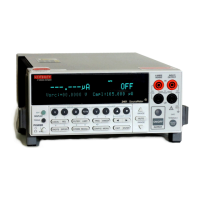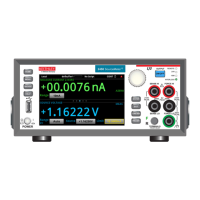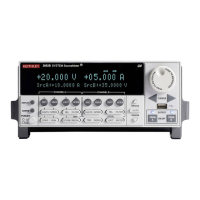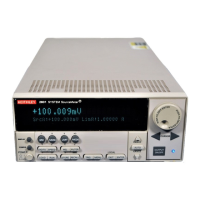18 Quick Results Guide
Auto ohms example — Table 10 shows a typical command sequence to use auto ohms to
measure resistance. Note that 4-wire sensing is used for this example. See Basic connections
for details on sensing.
Manual ohms example — Table 11 shows a typical command sequence to use manual ohms
to measure resistance. This example uses auto range for current measurements. If you were to
use manual ranging, you should select the lowest possible current range for the measurement.
For example, to measure a 1MΩ resistor with the source set to 2V, the 1µA measure range should
be selected to achieve the best accuracy (2V/1µA = 2MΩ). Note that 2-wire sensing is used for
this example. See Basic connections for details on sensing.
Table 10
Command sequence for auto ohms example
Command* Comments
*RST Restore GPIB defaults (one-shot measurement mode).
:SENS:FUNC “RES” Select ohms measurement function.
:SENS:RES:RANG 200 Select 200Ω range.
:SENS:RES:MODE AUTO Select the auto ohms measurement method.
:SYST:RSEN ON Select 4-wire sense mode.
:OUTP ON Turn the output on.
:READ? Trigger and acquire one data string.
*SourceMeter must be addressed to talk after sending :READ? to trigger and acquire data.
Table 11
Command sequence for manual ohms example
Command* Comments
*RST Restore GPIB defaults (one-shot measurement mode).
:SENS:FUNC “RES” Select ohms measurement function.
:SENS:RES:MODE MAN Select the manual ohms measurement method.
:SOUR:FUNC VOLT Select voltage source function.
:SOUR:VOLT:MODE FIX Select fixed voltage sourcing mode.
:SOUR:VOLT:RANG 2 Select 2V source range.
:SOUR:VOLT:LEV 2 Set source level to 2V.
:SENS:CURR:PROT 10e-3 Set current compliance to 10mA.
:SENS:CURR:RANG:AUTO
ON
Select auto range for current measurements.
:SYST:RSEN OFF Select 2-wire sense mode.
:OUTP ON Turn the output on.
:READ? Trigger and acquire one data string.
*SourceMeter must be addressed to talk after sending :READ? to trigger and acquire data.
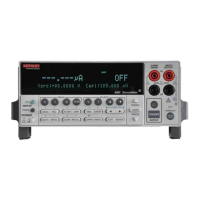
